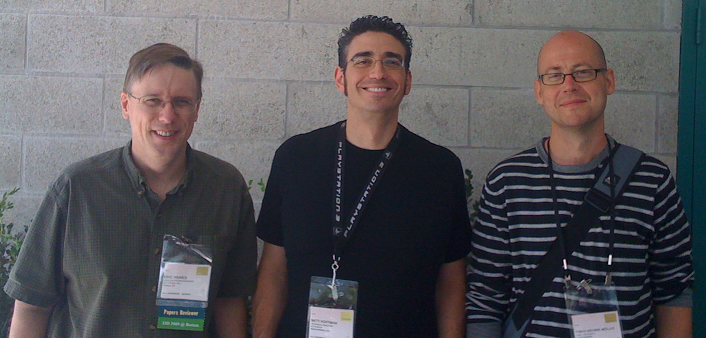This grab-bag of a post summarizes the various other features of Direct3D 11 which Microsoft described at Gamefest.
Dynamic shader linkage is supported (similar to the interfaces feature of Cg). This allows for separate light and material shaders to be written and compiled. These are later linked when the shader is set. This offers a solution to the combinatorial explosion resulting from a variety of lights and materials (this explosion, and some other solutions to it, are discussed in section 7.9 of our book).
Two new compressed texture formats have been added. BC6 supports high dynamic range RGB textures, using 1 byte per texel (instead of 6 bytes for an RGB 16-bit float texture). BC7 supports low dynamic range RGB or RGBA textures. It also uses one byte per texel (like DXT5/BC3), but offers significantly higher quality than texture formats available in D3D10. Both formats offer multiple block types (the compression tool selects the appropriate block type based on its content).
The block compression formats in D3D9 and D3D10 are based on the idea that each 4×4 texel block has all its values arranged along a single line, and the bits for each texel encode where on the line it is placed. For example, in DXT1/BC1, a line in RGB space is represented by two RGB endpoints, and each texel gets two bits to select one of four points along the line.
The new D3D11 formats support block types with one, two or even three (in the case of BC7) color lines. There is a tradeoff between the number of lines and the number of points along each line, since each block takes up the same amount of memory.
In principle, a 4×4 block with two color lines would need 16 additional bits per block to determine which line each texel was associated with (even more bits are needed for three color lines). To reduce storage requirements, only a subset of possible line association patterns are supported. The compression tool selects the best association out of this subset for each block.
Direct3D11 also tightens up the texture specifications. Decompression results must be bit-accurate, and subtexel/submip filtering precision is required to be at least 8 bits.
Direct3D11 increases the texture size limits from 8K texels to 16K texels. Note that a 16K x 16K DXT1/BC1 texture takes up 128MB – not many games will have textures this large! In general, D3D11 allows for resources as large as 2GB.
Hardware can optionally support double-precision floats. This was the only optional feature of D3D11 mentioned at Gamefest.
There was a slide listing a bunch of other features without further explanation. Most are a bit mysterious, but I list them here in case someone else is able to puzzle out what they mean:
- Addressable Stream Out
- Draw Indirect
- Pull-model attribute eval
- Improved Gather4
- Min-LOD texture clamps
- Conservative oDepth
- Geometry shader instance programming model
- Read-only depth or stencil views
This completes my report on Direct3D11 from Gamefest. Check the XNA Presentations Page for the slides and audio – they are not up there yet, but hopefully will be there soon.
